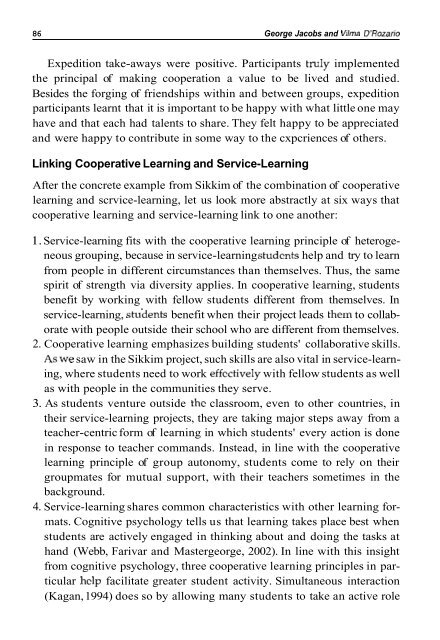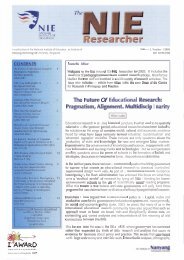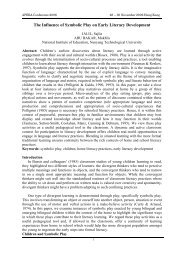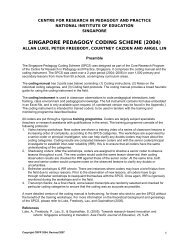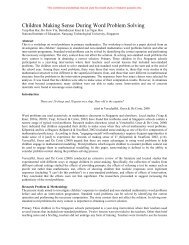Cooperative Learning - NIE Digital Repository - National Institute of ...
Cooperative Learning - NIE Digital Repository - National Institute of ...
Cooperative Learning - NIE Digital Repository - National Institute of ...
You also want an ePaper? Increase the reach of your titles
YUMPU automatically turns print PDFs into web optimized ePapers that Google loves.
86 George Jacobs and Vilma D'RozarioExpedition take-aways were positive. Participants truly implementedthe principal <strong>of</strong> making cooperation a value to be lived and studied.Besides the forging <strong>of</strong> friendships within and between groups, expeditionparticipants learnt that it is important to be happy with what little one mayhave and that each had talents to share. They felt happy to be appreciatedand were happy to contribute in some way to the cxpcriences <strong>of</strong> others.Linking <strong>Cooperative</strong> <strong>Learning</strong> and Service-<strong>Learning</strong>After the concrete example from Sikkim <strong>of</strong> the combination <strong>of</strong> cooperativelearning and scrvice-learning, let us look more abstractly at six ways thatcooperative learning and service-learning link to one another:1. Service-learning fits with the cooperative learning principle <strong>of</strong> heterogeneousgrouping, because in service-learning studcnts help and try to learnfrom people in different circumstances than themselves. Thus, the samespirit <strong>of</strong> strength via diversity applies. In cooperative learning, studentsbenefit by working with fellow students different from themselves. Inservice-learning, stu'dents benefit when their project leads them to collaboratewith people outside their school who are different from themselves.2. <strong>Cooperative</strong> learning emphasizes building students' collaborative skills.Aswe saw in the Sikkim project, such skills are also vital in service-learning,where students need to work effcctively with fellow students as wellas with people in the communities they serve.3. As students venture outside thc classroom, even to other countries, intheir service-learning projects, they are taking major steps away from ateacher-centric form <strong>of</strong> learning in which students' every action is donein response to teacher commands. Instead, in line with the cooperativelearning principle <strong>of</strong> group autonomy, students come to rely on theirgroupmates for mutual support, with their teachers sometimes in thebackground.4. Service-learning shares common characteristics with other learning formats.Cognitive psychology tells us that learning takes place best whenstudents are actively engaged in thinking about and doing the tasks athand (Webb, Farivar and Mastergeorge, 2002). In line with this insightfrom cognitive psychology, three cooperative learning principles in particularhclp facilitate greater student activity. Simultaneous interaction(Kagan, 1994) does so by allowing many students to take an active role


